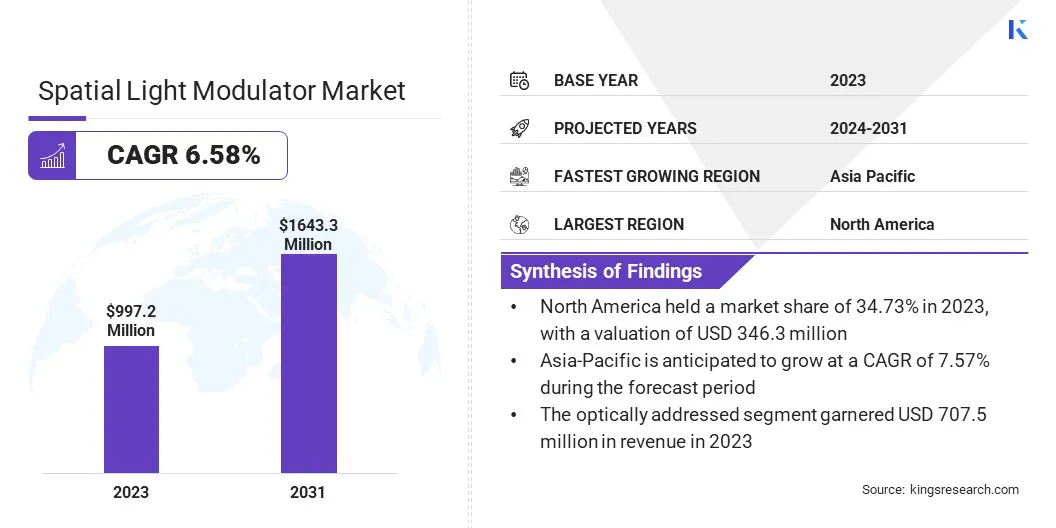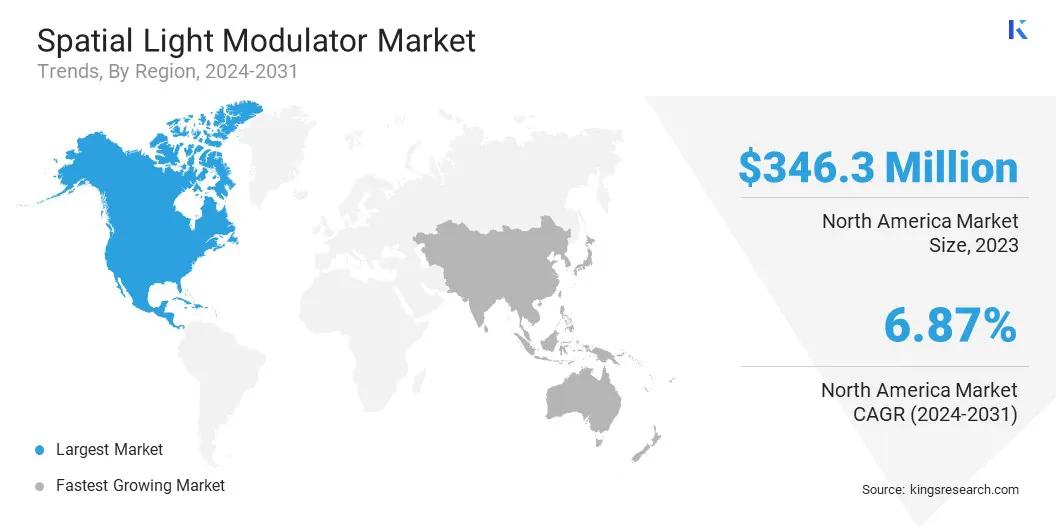Spatial Light Modulator Market Size
The global Spatial Light Modulator Market size was valued at USD 997.2 million in 2023 and is projected to grow from USD 1,051.6 million in 2024 to USD 1,643.3 million by 2031, exhibiting a CAGR of 6.58% during the forecast period.
The expansion of the market is driven by ongoing advancements in display technologies, rising demand for high-resolution imaging systems, and expanding applications in sectors such as telecommunications, consumer electronics, and defense.
In the scope of work, the report includes solutions offered by companies such as Hamamatsu Photonics K.K., Laser 2000, Meadowlark Optics, Perkin Elmer, Santec Holdings Corporation, Texas Instruments Incorporated., HOLOEYE Photonics AG, ELECTRO-OPTICAL COMPONENTS, INC., JENOPTIK AG, KOPIN, and others.
The rising adoption of augmented reality (AR) and virtual reality (VR) technologies, which require precise light manipulation, is fueling market growth. Additionally, the expansion of the consumer electronics sector, with higher demand for advanced projectors and displays, contributes significantly to the development of the market.
- For instance, according to a 2024 report by the India Brand Equity Foundation (IBEF), rising disposable income and technological innovation in Indiahave led to increased demand for consumer durable goods, resulting in fierce competition among brands. Multinational organizations have identified India as a key growth market. In FY24, electronics exports reached US$ 22.64 billion, with the aim of achieving US$ 300 billion in electronics manufacturing and US$ 120 billion in exports by FY26. The Indian consumer electronics and appliances market is expected to double by 2025.
Innovations in micro-electro-mechanical systems (MEMS) and liquid crystal on silicon (LCoS) technologies have significantly enhanced performance and reduced costs, thereby making SLMs more accessible and promoting their adoption across diverse industries.
The spatial light modulator market is experiencing substantial growth due to its expanding use in digital projectors, high-definition displays, and optical communication systems. Major applications encompass various fields such as entertainment, medical imaging, and military systems.
Regional growth varies, with notable advancements due to technological innovations and increasing demand for consumer electronics. The market's competitive landscape includes key players who are focusing on enhancing product capabilities and exploring new application areas.
A spatial light modulator (SLM) is an optical device that modulates light spatially based on input signals. It adjusts the light's intensity, phase, or polarization to create patterns or images in various applications, including displays, imaging systems, and telecommunications. SLMs use technologies such as liquid crystal on silicon (LCoS), digital micromirror devices (DMD), and micro-electro-mechanical systems (MEMS).
These devices are integral in high-precision optical systems, enabling functionalities such as adaptive optics, beam shaping, and high-resolution imaging. Their ability to control light dynamically and precisely makes them essential components in advanced technological applications and research.

Analyst’s Review
The spatial light modulator market is undergoing significant transformation, mainly propelled by key efforts from manufacturers to innovate and expand product offerings. Companies are actively developing advanced SLM technologies, such as high-resolution liquid crystal on silicon (LCoS) and micro-electro-mechanical systems (MEMS), to enhance performance and reduce costs.
- For instance, in March 2023, HOLOEYE expanded its SLM product range with the introduction of a new Spatial Light Modulator. This analog phase-only device features low latency, extreme phase stability, and low crosstalk. The ERIS SLM’s product specifications include a 0.717″ LCOS micro-display, an 8µm pixel pitch, and a resolution of 1920×1200 pixels.
Analysts recommend that stakeholders should prioritize investing in research and development to maintain a competitive edge and explore strategic partnerships to access emerging markets. Adopting trends such as miniaturization and integrating SLMs into new technologies are likely to play a crucial role in sustained growth and market leadership.
Spatial Light Modulator Market Growth Factors
The increasing demand for high-resolution displays is aiding the expansion of the market. As consumer electronics continue to advance, there is a growing need for devices that offer superior image quality and detail.
High-resolution displays, including those used in augmented reality (AR) and virtual reality (VR), require advanced SLMs to achieve precise light modulation and enhance visual experiences.
The expansion of these technologies into various sectors, such as entertainment and medical imaging, continues to boost the demand for SLMs. Innovations in SLM technologies, such as improvements in liquid crystal on silicon (LCoS) and micro-electro-mechanical systems (MEMS), are meeting this surging demand by delivering higher resolution and performance, thereby aiding spatial light modulator market growth.
A prominent challenge hampering the development of the market is the high cost associated with advanced SLM technologies, which limits their adoption in price-sensitive applications. This high cost is attributable to complex manufacturing processes and the need for precision components.
To overcome this challenge, companies are focusing on reducing production costs through technological advancements and economies of scale. Investment in research and development to enhance manufacturing efficiency and explore alternative materials is crucial.
Additionally, scaling up production and improving supply chain management helps lower costs, making advanced SLM technologies more accessible and appealing to a broader range of applications and industries.
Spatial Light Modulator Industry Trends
The integration of spatial light modulators (SLMs) in augmented reality (AR) and virtual reality (VR) systems is continuously growing. As AR and VR technologies continue to gain traction in entertainment, training, and simulation applications, the need for advanced SLMs to deliver high-quality, immersive experiences is increasing.
SLMs are enhancing the precision and clarity of light manipulation in these systems, thereby supporting higher resolutions and better performance. The trend toward integrating SLMs in AR and VR is further propelled by the rising demand for more realistic and engaging user experiences, advancements in SLM technology to meet the evolving requirements of these dynamic fields.
The shift toward miniaturization in electronic devices is influencing the landscape of the spatial light modulator market. As consumer electronics, such as smartphones and compact projectors, continue to become smaller and more portable, there is a rising demand for SLMs that are both compact and high-performing.
Manufacturers are responding to this trend by developing miniaturized SLM solutions that maintain high resolution and efficiency while fitting into smaller form factors. This trend is leading to innovations in micro-electro-mechanical systems (MEMS) and liquid crystal on silicon (LCoS) technologies, enabling the integration of advanced light modulation capabilities into increasingly compact and portable devices.
Segmentation Analysis
The global market is segmented based on type, end use, application, and geography.
By Type
Based on type, the market is categorized into optically addressed and electrically addressed. The optically addressed segment led the spatial light modulator market in 2023, reaching a valuation of USD 707.5 million. This notable expansion is fostered by its superior performance characteristics and growing applications in various high-precision fields.
Optically addressed spatial light modulators (SLMs) offer high resolution and fast response times, making them ideal for complex imaging and display systems. Their ability to handle high light intensities without performance degradation further boosts their adoption in advanced optical systems.
The increasing demand for high-quality imaging in sectors such as defense and research, coupled with advancements in optical technologies, continues to support the growth of the segment.
By End Use
Based on end use, the market is classified into telecommunication, consumer electronics, healthcare and medical, aerospace and defense, research and academia, and others.
The consumer electronics segment is projected to witness significant growth at a robust CAGR of 8.05% through the forecast period (2024-2031), largely attributable to the rising demand for high-definition displays and innovative visual technologies.
This segment benefits from the proliferation of devices such as smartphones, smart TVs, and projectors, which require advanced spatial light modulators (SLMs) for enhanced visual performance.
As consumer preferences shift toward more immersive and high-resolution experiences, the need for SLMs in consumer electronics continues to increase. Technological advancements and decreasing costs are making these technologies more accessible, thereby supporting the growth of the segment.
By Application
Based on application, the market is segmented into optical communication, display technology, holography, laser material processing, adaptive optics, and others.
The optical communication segment secured the largest spatial light modulator market share of 24.53% in 2023, primarily due to the increasing demand for high-speed data transmission and advanced communication networks. Spatial light modulators (SLMs) play a crucial role in optical communication by enabling precise control of light for data encoding and transmission.
The growing adoption of fiber optic technology and the expansion of telecommunications infrastructure are significantly contributing to segmental progress. Advances in SLM technologies that enhance data throughput and signal quality are further fueling the expansion of the optical communication segment.
Spatial Light Modulator Market Regional Analysis
Based on region, the global market is classified into North America, Europe, Asia-Pacific, MEA, and Latin America.

North America spatial light modulator market captured a major share of around 34.73% in 2023, with a valuation of USD 346.3 million. This dominance is reinforced by the region's advanced technological infrastructure and high adoption rates of cutting-edge display and imaging technologies.
The regional market benefits from a strong presence of major SLM manufacturers and frequent innovation in electronics and defense applications.
High investments in research and development, along with a robust telecommunications sector, contribute to this dominance. Additionally, a strong demand for high-resolution displays in consumer electronics and professional applications further solidifies North America’s leading position in the global market.
Asia-Pacific is estimated to experience robust growth at a CAGR of 7.57% over the forecast period. This rapid growth is facilitated by the region's expanding electronics manufacturing industry and increasing consumer demand for advanced display technologies.
The rise of emerging markets and substantial investments in telecommunications and healthcare technologies are further fueling domestic market growth. The presence of major electronics manufacturers and a growing focus on technological innovation in countries such as China, Japan, and South Korea support the regional market expansion.
Competitive Landscape
The global spatial light modulator market report will provide valuable insight with an emphasis on the fragmented nature of the industry. Prominent players are focusing on several key business strategies such as partnerships, mergers and acquisitions, product innovations, and joint ventures to expand their product portfolio and increase their market shares across different regions.
Manufacturers are adopting a range of strategic initiatives, including investments in R&D activities, the establishment of new manufacturing facilities, and supply chain optimization, to strengthen their market standing.
List of Key Companies in Spatial Light Modulator Market
- Hamamatsu Photonics K.K.
- Laser 2000
- Meadowlark Optics
- Perkin Elmer
- Santec Holdings Corporation
- Texas Instruments Incorporated.
- HOLOEYE Photonics AG
- ELECTRO-OPTICAL COMPONENTS, INC.
- JENOPTIK AG
- KOPIN
Key Industry Developments
- January 2024 (Acquisition): HOLOEYE acquired a significant portion of Jasper Display Corporation's LCOS technology portfolio. Jasper Display Corporation was known for its LCOS Spatial Light Modulators, digital modulation controller ICs, and microdisplays. This acquisition enabled HOLOEYE to expand its LETO and GAEA SLM product lines. Additionally, HOLOEYE committed to supporting former JDC SLM customers, ensuring the continuation of their academic and industrial research and development programs.
- June 2023 (Expansion): Texas Instruments Incorporated (TI) announced plans to expand its manufacturing capabilities in Malaysia by establishing two test factories and new assembly facilitates in Melaka and Kuala Lumpur. This expansion aimed to internalize 90% of TI’s assembly and test operations by 2030 to enhance supply chain control. The initiative was supported by the Malaysian government to strengthen the country's semiconductor industry and stimulate economic growth.
The global spatial light modulator market is segmented as:
By Type
- Optically Addressed
- Electrically Addressed
By End Use
- Telecommunication
- Consumer Electronics
- Healthcare and Medical
- Aerospace and Defense
- Research and Academia
- Others
By Application
- Optical Communication
- Display Technology
- Holography
- Laser Material Processing
- Adaptive Optics
- Others
By Region
- North America
- Europe
- France
- U,K.
- Spain
- Germany
- Italy
- Russia
- Rest of Europe
- Asia-Pacific
- China
- Japan
- India
- South Korea
- Rest of Asia-Pacific
- Middle East & Africa
- GCC
- North Africa
- South Africa
- Rest of Middle East & Africa
- Latin America
- Brazil
- Argentina
- Rest of Latin America


